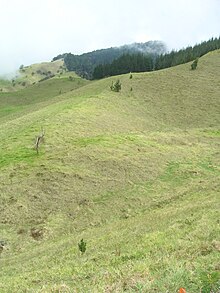Long-legged owl
| Long-legged owl | ||||||||||||
|---|---|---|---|---|---|---|---|---|---|---|---|---|
| Systematics | ||||||||||||
|
||||||||||||
| Scientific name | ||||||||||||
| Grallistrix erdmani | ||||||||||||
| Olson & James , 1991 |
The long-legged owl ( Grallistrix erdmani ) is an extinct species of owls from the genus Grallistrix . It was a comparatively small owl with relatively long legs and short wings that was endemic to Hawaii . During the day, she hunted songbirds such as honeysuckle birds that she caught from flight in the forests there . Presumably, like other Grallistrix species, it brooded in sand dunes.
The long-legged owl probably died out as a result of the Polynesians colonizing Hawaii . These brought rats and pigs with them to the islands, which led to the disappearance of several species of Hawaii's late Quaternary avifauna . Long-legged owl subfossils have so far only been found on Maui , but it was probably also common on Moloka'i .
features
The long-legged owl was the smallest species of its genus, but had slightly longer legs than the similarly large Oahu long-legged owl ( G. orion ) and was slightly smaller than a tawny owl ( Strix aluco ). Overall, it was built similar to a sparrowhawk ( Accipiter nisus ), with short, rounded wings, long, thin legs and very strong toes. The skull was rather atypical of owls, elongated and with more laterally aligned eyes than in recent species.
Ecology and diffusion
The long-legged owl likely hunted in dense rainforests due to its anatomy. Unlike most recent species, it hunted birds capable of flying during the day; most of the owls still alive today hunt nocturnal small mammals instead. The long-legged owl was well adapted for this way of life. Her physique allowed agile and quick flight maneuvers, which enabled her to beat flying prey out of flight.
Skeletal remains of the long-legged owl were found in the Owl Cave near the 1,402 m high Puu Makua on Maui. Their habitat was probably formed by the forested southern slopes of Haleakalā and the surrounding elevations. It was probably also widespread on the neighboring Molokaʻi , since these islands together with other islands formed Maui Nui during the Pleistocene . The long-legged owl probably died out when the Polynesians reached the Hawaiian archipelago between the 6th and 11th centuries and introduced pigs and Pacific rats ( Rattus exulans ). The ground-breeding bird species were exposed to sudden pressure from nest robbers, as a result of which most of them died out.
Taxonomy and research history
Long-legged owl subfossils were first found on Maui in 1986 by Storrs Lovejoy Olson and Helen Frances James , who first described the species in 1991. Together with three other similar species it was placed in the newly established genus Grallistrix ("stilted owls").
No DNA analyzes are currently available for the systematics of the genus Grallistrix . However, due to their similar morphology, Olson and James placed them close to the genus Strix . The long-legged owl is probably not more closely related to the similarly large Oahu long-legged owl ( G. orion ) than to other species of the genus, since the Molokai long-legged owl ( G. geleches ) lived between the distribution areas of the two species and thus separated them spatially.
Sources and References
literature
- Storrs L. Olson , Helen Frances James : Descriptions of thirty-two new Species of Birds from the Hawaiian Islands. In: Ornithological Monographs 45, June 1991. ISBN 0-935868-54-2 . (Available online as PDF )
- Harold Douglas Pratt : The Hawaiian honeycreepers: Drepanidinae. Oxford University Press, 2005. ISBN 019854653X
- Beth Slikas : Lessons from a rediscovered avifauna. In: The Auk 120, No. 4, 2003. pp. 953-960. doi : 10.1642 / 0004-8038 (2003) 120 [0953: HBLFAR] 2.0.CO; 2
